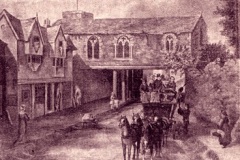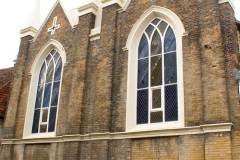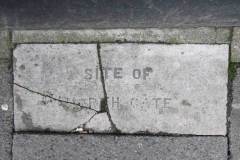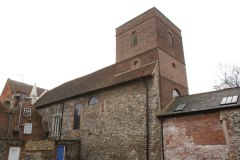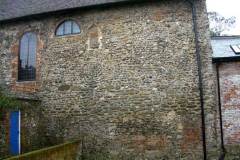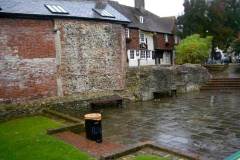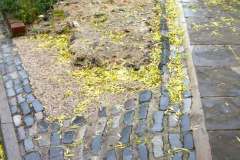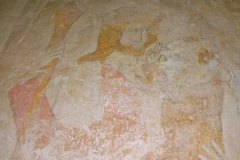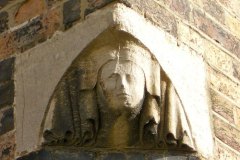Borough / St. Radigund’s Street
Introduction
The Northgate to the city is no longer visible, but you can still see part of the original Roman wall and walk on the foundations of the medieval wall here.
History
Little is known about the original gate, which was on the route to the Isle of Thanet. However, it was where Archbishop Alphege was taken following the sack of the Cathedral by the Danes in 1011 before being taken by boat to Greenwich where he was eventually martyred. It was also here that the City Mayor, Recorder and Aldermen met the medieval Kings of England to give them the keys to the city when they returned from the continent across the channel via Margate.
From c.1300 the church of St. Mary Northgate was incorporated above the gate, which was later developed to allow both horse carriage and pedestrian access (Image 1). The church was rebuilt in 1773 and again in 1830 when the gate was demolished , the only visible sign being a commemorative Cozen’s paving slab. The architecture is undistinguished, utilising Egyptian style obelisks and inverted crosses above neo Gothic windows at the East and with a square brick tower at the West. The church was deconsecrated in 1912 and is now owned by King’s School.
The various rebuilds did however retain the southern wall which incorporates part of the original Roman city wall which can be viewed from a sunken garden accessed via St Radigunds. In the garden there is a comprehensive information board from which the sections of the wall and its route can be identified. The foundations of the medieval wall extending towards Westgate are exposed at the end of the garden.
What to see:
- St. Mary’s 1830 Egyptian style Western facade (Image 2).
- Cozen’s pavement plaque commemorating the demolished gate (Image 3).
- Tower and south wall from the sunken garden (Image 4).
- City wall incorporated into St. Mary’s Southern wall, explained by the nearby information board (Image 5). Pre-12th century crenellation can be seen (with the eye of faith) just below the small bricked-in window.
- The sunken garden, church and the Parrot Inn (Image 6).
- Foundations of City wall extending towards Westgate (Image 7).
- An original wall painting inside the north wall (Image 8).
- An unusual face sculpture on south east corner of church (Image 9).
Access: There is no access to the church but the sunken garden and information board is permanently accessible
Sources: Hasted (1800): Gardiner (1933): Lyle (2008)
SR

